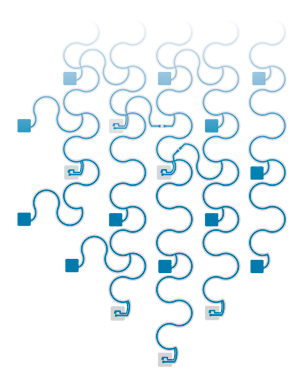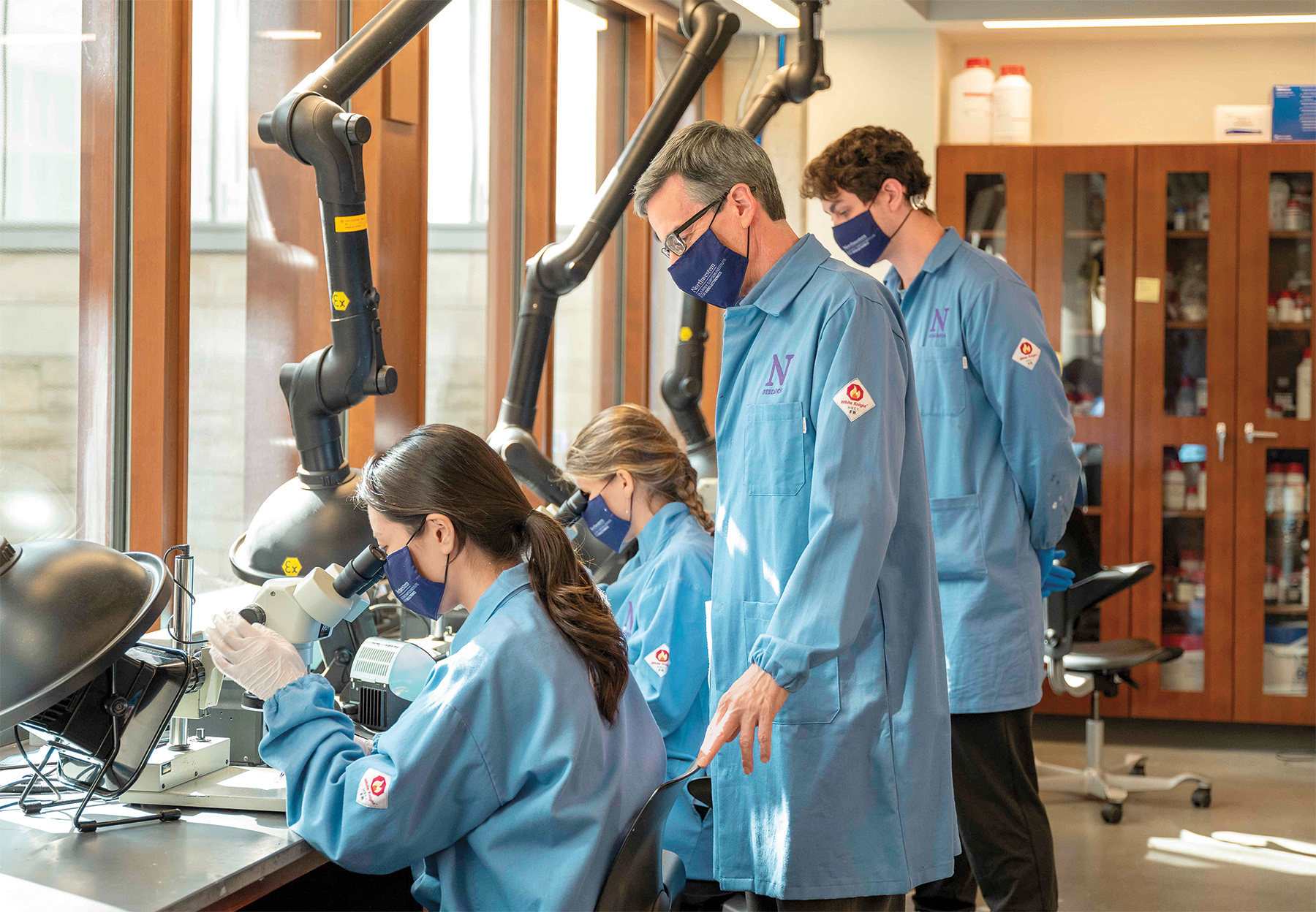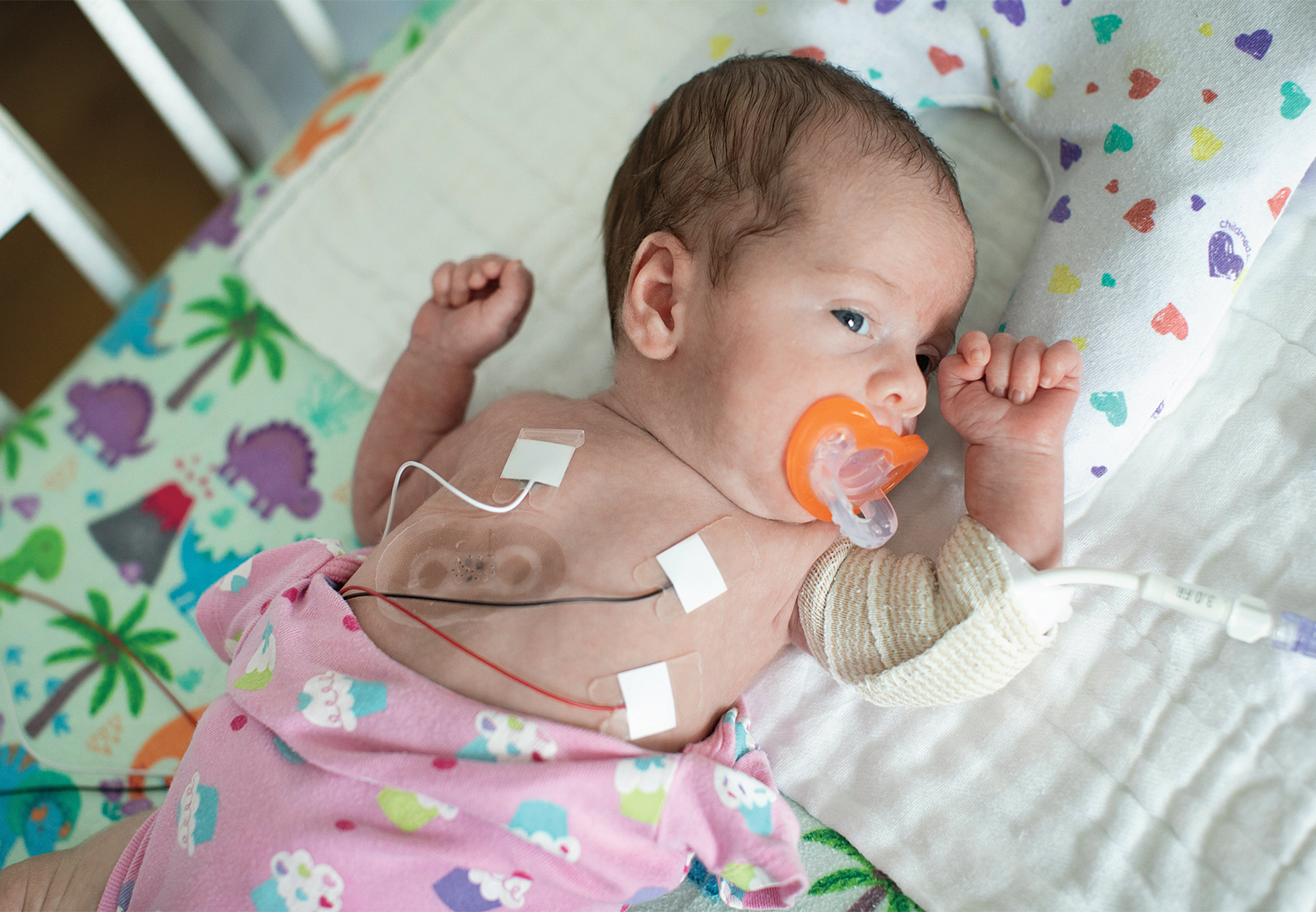Putting Patients First to Stop Ebola
Virologist Daniel Bausch says the solution to containing infectious disease outbreaks is to first engage communities — and win people’s trust.
Pioneering professor John Rogers founded a new field of bioelectronics to improve human health. By Amanda Morris
John A. Rogers has invented a mind-boggling number of electronic devices. Do you want to measure your sweat’s chemistry to check hydration? There’s a device for that.
Monitor exposure to harmful levels of ultraviolet radiation from the sun with a sensor smaller than an M&M? There’s a device for that.
Jump-start your heart with an ultrathin, stretchable “sock” that acts as a pacemaker? There’s a device for that.
Or map your brain’s electrical signals with a sensor that softly laminates onto the organ’s wrinkled, folded surface and then harmlessly dissolves, making a second surgery to remove the sensor unnecessary? There’s a device for that, too.
How about “artificial skin” that creates the sensation of touch in virtual reality environments? Or an implant that senses when the user has ingested a fatal level of opioids, delivers a lifesaving antidote and calls emergency responders?
Yes. Believe it or not, Rogers has developed bioelectronics for all these applications and more.

By making the electrical components wavy, Rogers ensures that his devices can withstand stretch and strain, enabling otherwise rigid electronics to move and flex with the human body.
When talking to Rogers, it’s clear that research is not just an exercise of the mind. It’s a highly competitive, full-contact sport. It’s an arena where boundaries are pushed to extreme limits and electronics become impossibly thin, flexible, stretchy and smart — blurring the distinction between body and device.
“I’m not competitive against other people, necessarily, but competitive with myself,” says Rogers, who directs Northwestern’s Querrey Simpson Institute for Bioelectronics. “In my lab, we want to go as high as we can go in terms of rigor and impact. We want to do more and get to the endpoint faster.”
With more than 750 published journal papers, more than 100 patents and more than 130,000 citations, Rogers is playing his best game. He is the Michael Jordan of technology — unstoppable, unflinching and agile enough to pivot his research when a medical need unexpectedly arises.
“John is truly motivated by his desire to help people,” says longtime collaborator Yonggang Huang, the Jan and Marcia Achenbach Professor of Mechanical Engineering at Northwestern. “The faster he can move from idea to invention, the faster he can get his devices onto the patients who need them. John’s vision is to create a new field that benefits society.”

Rogers, who is the Louis A. Simpson and Kimberly Querrey Professor of Materials Science and Engineering, Biomedical Engineering and Neurological Surgery, doesn’t just lead the field of stretchable bioelectronics — he founded it. But with his mild demeanor and subtle Texas lilt, Rogers is so unassuming that people might not expect such extraordinary achievements. He is a highly decorated researcher, with a MacArthur “genius grant” to his name. He also is just one of approximately two dozen people in history to be elected to all three national academies: The National Academies of Sciences, Engineering and Medicine.
“You might expect someone with as many awards and honors to have a big ego. But he is a humble, pleasant, caring colleague,” says collaborator Amy Paller ’83 GME, the Walter J. Hamlin Professor of Dermatology.
Rogers grew up outside Houston, where his mother wrote science-inspired poetry and his father was a physicist. He caught the research bug while an undergraduate at the University of Texas at Austin. A double-major in physics and chemistry, Rogers pursued an undergraduate research position in the laboratory of Professor Richard “Dick” Lagow, who was famous for “extreme chemistry,” or research into highly reactive compounds, with a focus on the most reactive element of them all, fluorine.
“He was energized not only by the research but also by the competitive landscape of academic science,” Rogers says of Lagow. “I thought that being an academic meant that you sat in an ivory tower and thought big, profound thoughts. I didn’t fully appreciate that it was also so competitive. Dick enjoyed competing against other labs, trying to do something better or something different. I found that whole environment exciting.”
From there, Rogers pursued a doctorate at the Massachusetts Institute of Technology, where he met Lisa Dhar, who he married in 1996. (She is now director of New Business Ventures for Engineering at Northwestern.) Then Rogers became a Harvard Junior Fellow, studying with materials science great and renowned chemist George Whitesides ’20 H. Rogers quickly built a reputation for himself. Fellow postdoc Joanna Aizenberg remembers review meetings in which group members presented their research results.
“Nobody wanted to present after John,” says Aizenberg, who is now a materials science professor at Harvard. “We constantly fought about it. His presentations were awe-inspiring. It was embarrassing to follow that. It was obvious, even back then, that he would do great things.”
After their postdoctoral fellowships ended at Harvard, Rogers and Aizenberg reconnected at the storied Bell Labs, where they shared an office. By this time, Rogers — who grew up playing with Legos and Erector Sets — had realized that he enjoyed building things and designing gadgets, so he expanded his research focus from chemistry and physics to various aspects of engineering. At Bell Labs, he worked on the backplane circuits for electronic paper displays, which became the basis for e-readers such as the Kindle, and on advanced fiber-optic devices for data communications, which became cornerstones for the fastest networks at that time.
Aizenberg describes Rogers as someone who loved his work so thoroughly that he spent days and nights in his office, listening to heavy metal on his headphones and fueling himself with iced tea. “I don’t think he ever slept,” says Aizenberg. “It was clear that he truly enjoyed his work and being in the office. And for me, it was like being next to greatness. He’s absolutely unmatched.”
Like many researchers around the globe, Brian Litt, a professor of neurology and bioengineering at the University of Pennsylvania, took note of Rogers’ discovery.
Litt has devoted his life to better understanding the brain in order totreat epilepsy patients. To further this work, he envisioned implantable devices to map epileptic networks. He saw the potential for Rogers’ electronics to perhaps achieve the impossible — to monitor select, localized areas of the brain without causing damage. Litt and his team approached Rogers after a presentation.
“They asked if I ever thought about putting my flexible electronic systems onto the brain to monitor electrical activity or stimulate it for treatment,” Rogers says. “That was an eye-opener for me. It represented a new direction, much different than our work on displays and communication systems. A bio-interface sounded really interesting, with clear potential for tremendous societal value in human health.
The challenge of engineering a device for the brain, however, is enormous and daunting. The human brain is a jiggly maze of wrinkled peaks, shallow grooves and deep fissures. With the consistency of gelatin, it can be depressed by the most delicate touch. Finding new tools to map and stimulate the brain could unlock the potential to restore lost brain function or cure debilitating disease. But failure carries the risk of hemorrhage or even permanent damage to the organ that houses intellect, creativity, emotions and memories.
“This presented a whole new set of challenges from a fundamental materials-science standpoint,” Rogers says. “To integrate an electronic device onto a very complex topographical surface like the brain, and to do so in a manner that doesn’t damage the fragile tissues or the technology, you have to build devices that can contort in very complex ways to follow the irregular geometry — in materials that both are biocompatible and enable high-performance operation.”
After the dot-com bubble collapsed, taking Bell Labs with it, Rogers came home to academia, joining the University of Illinois at Urbana-Champaign and the Beckman Institute for Advanced Science & Technology in 2003. In 2005 a single thread of silicon changed the direction of his research — and his life.
Rogers sought to develop a hybrid material that could transform brittle, rigid silicon into a flexible and stretchy rubber band. The U.S. military funded Rogers’ lab to create large-format electronic wireless communication systems that could be unfurled in a battlefield situation and then rolled up and tossed into a backpack for urgent, easy transport.
“Prior to that, our work focused on plastic-based materials as the basis for such types of flexible electronic systems,” Rogers says. “That approach can work pretty well for simple devices like displays, but the performance tends to fall short for more demanding applications.”
Rogers knew that thinner materials, by nature, become increasingly flexible. It’s like the thickness of a sheet of paper versus that of a two-by-four. Both are the same material — wood fiber — but their geometries dictate their mechanics. Rogers’ team was exploring silicon ribbons, each just one-thousandth the thickness of a strand of hair. After a serendipitous accident, a postdoc noticed that under certain conditions these silicon ribbons spontaneously adopted rippled or wavy shapes when bonded to a rubber substrate in the right way.
“We immediately realized that if silicon was in that configuration, we could stretch it back and forth like an accordion,” Rogers says. “We could twist it, bend it, crumple it up. It was almost indestructible.”
Rogers leveraged the discovery to build the first-ever stretchable transistor as a key building block for integrated circuits. When the research was published in the journal Science in 2006, the paper hit MIT Technology Review’s top-10 list of best discoveries that year and was downloaded tens of thousands of times.
“John was the first person to change the geometry of electronics,” says Northwestern colleague Yonggang Huang, who has published more than 300 papers over 15 years with Rogers. “He made the silicon wavy, and he coiled the wires like a spring. He’s very clever.”
Rogers joined Litt and his team to develop wireless, skinlike, biocompatible monitors for the brain that could last many decades without degrading — or that would, after a set number of days, harmlessly dissolve. After this initial project, Rogers was hooked on designing devices for other organ systems of the body. Next, his team tackled the heart, developing devices that softly adhere to the surface to monitor activity or even jump-start it like a pacemaker.
“John recognized that medical devices were the right direction for the group,” says Tony Banks, who has worked in Rogers’ labs at both the University of Illinois and Northwestern. “It very quickly became apparent that our group’s research on medical devices could help someone’s life. That became a huge driving motivation not only for John but for everyone in our group.”
After innovating for the heart and brain, Rogers decided to tackle the body’s biggest organ: the skin. “We didn’t need animal models to test the devices or collaborators to perform surgeries,” Rogers says. “With skin, we could build devices in our own lab and test them on ourselves.”
Before the Fitbit or smart watches, Rogers’ team invented the first wearable device to monitor health in 2007. Called epidermal electronics, the platform showcased a wireless, tattoo-like device that easily adhered to the skin to measure simple vital signs, such as cardiac activity and body temperature. The research marked a conceptual breakthrough and presented a road map for developing thin, high-performance electronic systems integrated with the body.
“John always has a keen sense of what will happen next in science — before it starts to happen,” says Banks, one of Rogers’ closest friends. “He has the ability to predict the next big thing.”

Oftentimes, Rogers develops new devices without knowing what future problems the technology might solve. His team developed a sensor to measure blood flow, for example, and then learned it could be used for hydrocephalus patients. Much like the serendipitous interaction with Litt some years before, this opportunity developed from a discussion with Matthew Potts, assistant professor of neurological surgery at the Feinberg School of Medicine, and Amit Ayer ’19 MBA, a recent neurosurgery resident at Feinberg, following a Rogers neurosurgery seminar.
Hydrocephalus, a potentially life-threatening condition in which excess fluid builds up in the brain, affects nearly 1 million Americans. Treatment includes surgically implanting a brain shunt, a straw-like catheter that drains fluid from the brain. Shunts have a nearly 100% failure rate over 10 years, and a malfunctioning shunt can cause headaches, fatigue and even death, if left untreated.
Rogers repurposed his blood-flow sensor to instead gauge the flow of fluid through a shunt. The Band-Aid–like sensor could revolutionize the way patients manage hydrocephalus and potentially save the U.S. health care system millions of dollars. Beth Meyer, whose son Willie was diagnosed with hydrocephalus as an infant, is keenly aware of how life-changing the device might be. Over the past 28 years, Willie has undergone more than 190 surgeries to diagnose or repair a malfunctioning shunt.
“Shunts work fine for a lot people, but when they don’t, you’re in big trouble,” says Beth, who lives in Arlington Heights, Ill. “Dr. Rogers’ device is a game changer. It’s painless, it’s noninvasive, and you can quickly determine whether the shunt is working properly or not. It could potentially save lives and money — and anxiety.”
Similarly, Rogers re-engineered his epidermal electronics to monitor premature babies, following a discussion with Amy Paller after a presentation at the annual meeting of the Society of Investigative Dermatology. His team’s resulting wireless device — designed with preemies’ fragile skin in mind — carries the promise of removing the tangle of wires that restrict movement and prevent parent-baby bonding. A father himself, Rogers profoundly understood the project’s potential impact.
After launching the devices in Chicago-area hospitals, the wireless monitoring systems for premature babies have been deployed to families in 26 countries, including resource-poor settings in Zambia, Kenya and Ghana. Now the devices exceed the capabilities of existing, wired monitoring technologies to provide information beyond traditional vital signs, including a baby’s crying, movement, body orientation and heart sounds. With support from the Bill & Melinda Gates Foundation and Save the Children, Rogers’ team will complete a program of testing the sensors on 15,000 pregnant women and 500 babies by the middle of 2021.
In March 2020 the accelerating momentum of Rogers’ research slammed into the same wall that hit the rest of the world. The coronavirus pandemic shut down Northwestern, and the University’s research operation ground to a halt.
As the Technological Institute’s hallways grew quiet, Rogers continued to visit his office and lab every day. Then his collaborators from the Shirley Ryan AbilityLab called, wondering if it might be possible to re-engineer a Band-Aid–sized device that he developed to track swallowing and speech sounds in recovering stroke patients to instead monitor cough, shortness of breath and vital signs in COVID-19 patients and front-line health care workers.
Two weeks after the phone call, Rogers’ team had already produced a working device. A month later, they launched a pilot program to test the device on health care workers and patients at Shirley Ryan AbilityLab and Northwestern Memorial Hospital. Rogers applied for essential status (exemption from the Illinois’ stay-at-home order), and his team manufactured each device in the lab.
“John didn’t miss one day of work,” says Banks. “Before students and postdocs returned, John and I were in the lab making COVID sensors. We personally went down to the hospital to put them on patients and work with the doctors.”
This is no surprise to Shuai “Steve” Xu, medical director of the Querrey Simpson Institute for Bioelectronics.
“I don’t think John gets enough credit for his empathy,” says Xu ’18 GME. “Beyond his technical brilliance, he puts himself in others’ shoes to genuinely understand their problems. And then he will do anything in his power to solve those problems.”
Amanda Morris ’14 MA is senior editor of science and engineering in Northwestern’s Office of Global Marketing and Communications.
Reader Responses
Hydration is important to diabetics of either type. Continuous glucose monitors (CGM) are becoming the primary monitors for diabetics replacing periodic finger sticks.
I am a type-2 diabetic who is taking a drug (Farxiga) that eliminates excess glucose in urine, so monitoring my hydration is vital. It would be great to either add a hydration monitor and phone app to my existing CGM and app or better yet add that ability directly to my CGM itself.
—Darryl Baker Evanston, via Northwestern Magazine
What a tremendous presentation about a truly amazing and inspirational person. I agree, it is great to know that there are awesome pioneers among us!
—Greg Messina '76 DDS, Rockford, Illinois
Fabulous piece, beautifully reported, written, photographed, filmed and produced. I have an 8-year-old granddaughter in Texas who tells us she wants to be a scientist. I cannot wait to share this with her and her family.
—Van King '73 MS, Greensboro, N.C., via Northwestern Magazine
Super interesting and thoughtful article! This piece really helpfully explains the significance of these important devices and discoveries for those of us not in the sciences. Great read!
—Annika Mann '03, Phoenix, via Northwestern Magazine
What a fascinating, well-written and deeply researched piece.
Going into this article, I didn’t know anything about Dr. Rogers’ incredible career, and I feel that I learned so much.
I’m heartened to know there are people like Dr. Rogers who are committed to using their brilliance help our world!
—Elise Clerkin '03, Oxford, Ohio, via Northwestern Magazine
No one has commented on this page yet.
Submit a Response